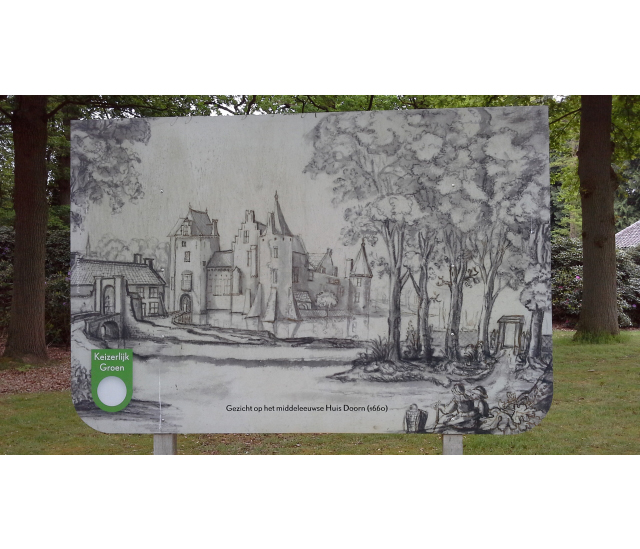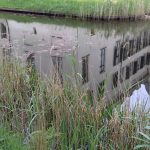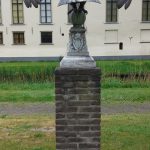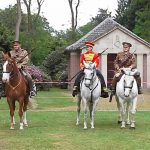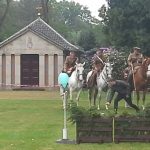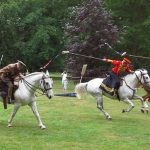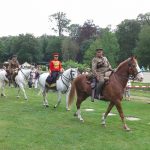‘Whatever happened to the Likely Lads?’ The same question could be asked of Friedrich Wilhelm Victor Albert, better known to us as ‘The Kaiser’.
Before WW1, the Kaiser was a jet-setting celebrity. During WW1, he was a household bogeyman, always in the papers and satirised in cartoon and song. By the end of the War the notoriety of the last German Emperor had faded. The man who could claim to be related to all the major Royal families in Europe slipped from the public stage to an enforced, obscure, private retirement on a modest country estate in the Netherlands called Huis Doorn. Following his abdication from the throne in November 1918, this became his home. It was for him a ‘gilded cage’ that he could not leave without special permission until his death in 1941.
His body still lies in a coffin draped with the imperial German flags inside a specially built mausoleum on the estate. No one except close relatives, or people granted special permission, is allowed to enter, but by peering through the stained glass windows and shading out the sun with one’s hands it is possible to see a little of what lies inside.
Sussex Yeomanry Mounted Skill-at-Arms Group was fortunate to receive (via the group Crown & Empire) an invitation to take part in the fourth Living History weekend event at Museum Huis Doorn. We packed our horses, equipment and ourselves into two horse boxes and made the long journey via Dover, Calais and the dreaded ring road round Antwerp to the Netherlands. Our arena was beside the castle and in front of the Kaiser’s mausoleum. The horse boxes were parked nearby. It was a strange feeling to be cleaning and polishing equipment and riding less than 100 yards from the remains of a man who had at one time been so influential. It brought to mind the poem by Shelley – Ozymandias.
For those interested in European history, Huis Doorn is a treasure trove of artefacts and information. The house/castle is set in a beautiful small estate and is full of royal household possessions. The Kaiser was given permission to take five train loads (a total of 59 carriages) of various items, including portraits, furniture, uniforms, swords, porcelain, silver, everyday utensils and much, much, more, from three of his palaces in Germany. A great deal of the items that were transported are still in storage because Huis Doorn was not big enough to house them all. If the Kaiser were to return to his home today, he would find that very little has changed since he left, even down to his bedroom slippers by his bed!
The Netherlands were neutral in WW1. Because of this and the Kaiser’s royal Dutch relations he felt able to claim and receive asylum. He would not have been welcome in Germany and the British wanted to try him as a war criminal. On the strict understanding that the Kaiser abdicate and take no part in politics, the Netherlands agreed to grant him asylum.
At the end of WW2 the Dutch government confiscated German property in the Netherlands. Huis Doorn and its contents became the property of the Dutch government. Today Huis Doorn is run as a museum. There is a small team of full-time employees and a large number of volunteers. The knowledge, enthusiasm and hospitality of all members of staff were outstanding. Everyone took a great deal of trouble – a special display of the Kaiser’s uniforms and swords were put together for the re-enactors to see. We were even taken to see the servants’ quarters up in the eaves of the house – something hitherto not seen by members of the public.
Museum Huis Doorn is a gem for the historian and art (especially porcelain) enthusiast. From time-to-time one finds a pub, restaurant or wine that nobody knows about, but it is excellent. Huis Doorn is one of these places. If ever you are in the Netherlands, south of Amsterdam, the museum at Doorn is definitely a place to visit. Give yourself plenty of time to stroll, browse and contemplate – you will need it! When you have finished, go to the café – the coffee and cognac are excellent!
- Sussex Yeomanry at Huis Doorn – Courtesy of John Dudeney
- Sussex Yeomanry at Huis Doorn – Courtesy of John Dudeney
- Sussex Yeomanry at Huis Doorn – Courtesy of John Dudeney
- Sussex Yeomanry at Huis Doorn – Courtesy of John Dudeney
- Sussex Yeomanry at Huis Doorn – Courtesy of John Dudeney
- Sussex Yeomanry at Huis Doorn – Courtesy of John Dudeney
This story was submitted by John Dudeney

